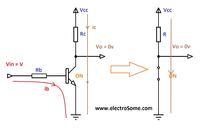brianfernandes
Newbie level 4
- Joined
- Aug 25, 2016
- Messages
- 5
- Helped
- 0
- Reputation
- 0
- Reaction score
- 0
- Trophy points
- 1
- Location
- Pune, India
- Activity points
- 75
I've been able to successfully use a 2n2222 transistor as a switch in my circuit, the switching part of which looks like the schematic below. My load is actually a **broken link removed** which takes the place of Rc in the above diagram. I've only activated one relay though, and this is still at the design stage, so I'm asking additional questions here so I can be sure this is a good long term design too.

All articles on the "transistor as a switch" subject will recommend that Ib should be calculated using a variation of Ic / Hfe (ignoring gain curves, temp, etc.)
1) My first question is - why? Isn't the load being supplied from Vcc, and that's where Ic would be drawn from? The transistor itself is not amplifying Ib to produce Ic ... or is it? Not sure how I should be analyzing that circuit since it has two voltage sources.
2) Say Hfe is 100 and Ib is 0.5mA, then Ic = 100*0.5mA = 50mA. Suppose my load was drawing 100mA, what would happen? Would the transistor burn out or simply go off saturation and be inefficient?
3) The current drawn by my load is variable. Since it is a 4 channel relay, the current required depends on the number of relays activated. From what I know, it can vary from a little current required, to about 80 - 100mA (at 20mA per activated relay). If I do use the above calculations and design for an Ic that's say, 150mA (to be safe) - what would happen when my relays are inactive, would the current be wasted through the emitter and cause some heating there? How would this affect the lifespan of the transistor, and would this be an inefficient design (at least 70% of the time, the relays would be off).
I know these questions are rather fundamental, but unfortunately I've forgotten what little AC design I've learned at university. Any explanation would be appreciated.
Thanks!

All articles on the "transistor as a switch" subject will recommend that Ib should be calculated using a variation of Ic / Hfe (ignoring gain curves, temp, etc.)
1) My first question is - why? Isn't the load being supplied from Vcc, and that's where Ic would be drawn from? The transistor itself is not amplifying Ib to produce Ic ... or is it? Not sure how I should be analyzing that circuit since it has two voltage sources.
2) Say Hfe is 100 and Ib is 0.5mA, then Ic = 100*0.5mA = 50mA. Suppose my load was drawing 100mA, what would happen? Would the transistor burn out or simply go off saturation and be inefficient?
3) The current drawn by my load is variable. Since it is a 4 channel relay, the current required depends on the number of relays activated. From what I know, it can vary from a little current required, to about 80 - 100mA (at 20mA per activated relay). If I do use the above calculations and design for an Ic that's say, 150mA (to be safe) - what would happen when my relays are inactive, would the current be wasted through the emitter and cause some heating there? How would this affect the lifespan of the transistor, and would this be an inefficient design (at least 70% of the time, the relays would be off).
I know these questions are rather fundamental, but unfortunately I've forgotten what little AC design I've learned at university. Any explanation would be appreciated.
Thanks!